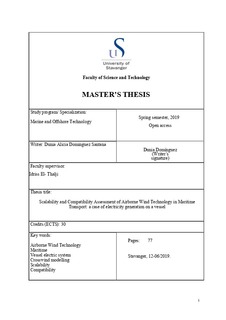| dc.contributor.advisor | El-Thalji, Idriss | |
| dc.contributor.author | Domínguez Santana, Dunia Alicia | |
| dc.coverage.spatial | North Sea | nb_NO |
| dc.date.accessioned | 2019-10-08T11:00:19Z | |
| dc.date.available | 2019-10-08T11:00:19Z | |
| dc.date.issued | 2019-06-12 | |
| dc.identifier.uri | http://hdl.handle.net/11250/2620879 | |
| dc.description | Master's thesis in Offshore Technology : Subsea technology | nb_NO |
| dc.description.abstract | The Maritime industry is facing a challenge in reducing its dependency on fossil fuels. New regulations established to reduce the GHG emissions by maritime transport, force sector stakeholders to apply measurements and study new technologies for propulsion and electricity generation on board of seagoing vessels. Generally, wind energy is a source freely available in the oceans. New developments in the wind industry are working towards high altitude wind turbines, also known as Airborne Wind Energy Systems (AWES). These systems have gained significant ground with the availability of high performance and lightweight tether material, computational power, and advanced control technologies. However, applications of this technology in the Maritime industry are limited to ship propulsion only. Additionally, there are no scalability studies of Airborne Wind Turbines as electricity generators on board of a vessel. Therefore, the objective of this thesis is to develop a scalability and compatibility model for airborne wind technology for electricity generation on board of a ship. To achieve this goal, a case scenario based on the current 30 kW prototype of Kitemill and the FSU Njord Bravo have been studied. The stage of this technology as electricity generation on board, according to the Technology Readiness Level (TRL), is stage 2 – technology concept and/or application formulated. This means that the simplified models presented in this thesis lead to valid and reliable results for this phase of technology design. On one hand, the scalability model developed indicates that the traction force is the most critical parameter for the scalability of the Airborne Wind Turbine (AWT). On the other hand, the compatibility model shows that there is a notorious complexity in merging airborne and ship technology due to their context. Consequently, this research appears to be relevant for both, the industry developing airborne technology and the maritime industry. Lastly, this thesis provides a foundation for future research in this innovative application. | nb_NO |
| dc.language.iso | eng | nb_NO |
| dc.publisher | University of Stavanger, Norway | nb_NO |
| dc.relation.ispartofseries | Masteroppgave/UIS-TN-IMBM/2019; | |
| dc.rights | Navngivelse 4.0 Internasjonal | * |
| dc.rights.uri | http://creativecommons.org/licenses/by/4.0/deed.no | * |
| dc.subject | offshore teknologi | nb_NO |
| dc.subject | undervannsteknologi | nb_NO |
| dc.subject | airborne wind technology | nb_NO |
| dc.subject | maritime technology | nb_NO |
| dc.subject | vessel electric system | nb_NO |
| dc.subject | crosswind modelling | nb_NO |
| dc.subject | scalability | nb_NO |
| dc.title | Scalability and Compatibility Assessment of Airborne Wind Technology in Maritime Transport: a case of electricity generation on a vessel | nb_NO |
| dc.type | Master thesis | nb_NO |
| dc.subject.nsi | VDP::Technology: 500::Marine technology: 580::Offshore technology: 581 | nb_NO |

